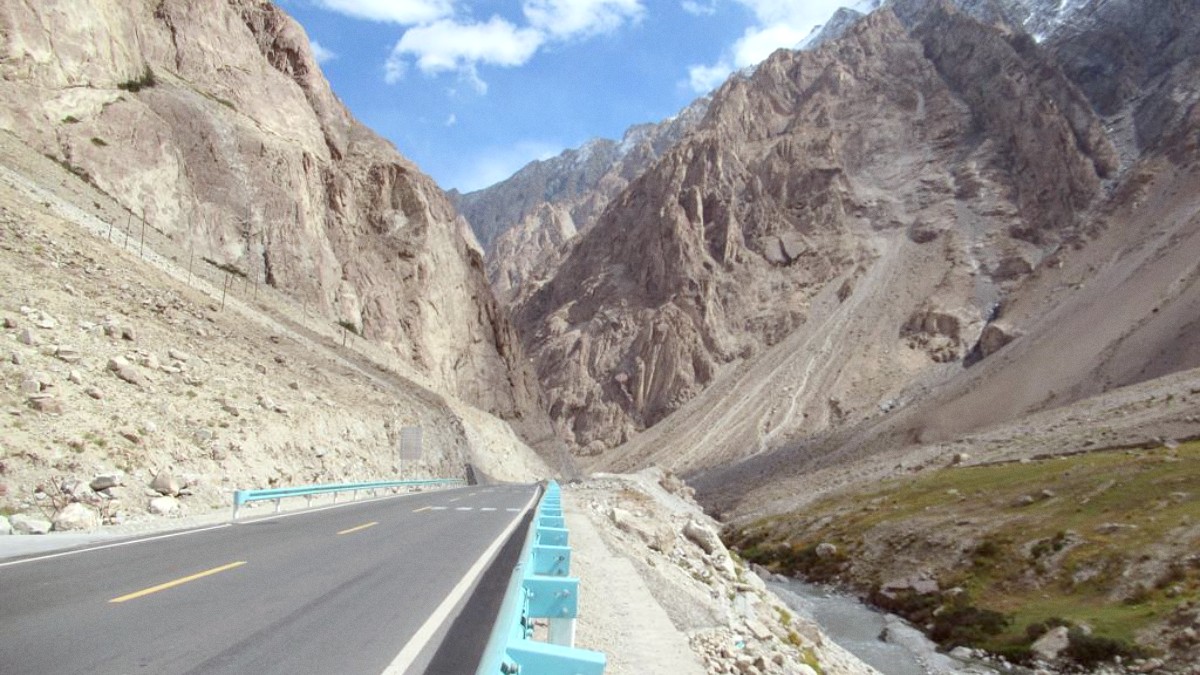
Pakistan
Certain sites along the KKH are must-visits, offering a blend of natural beauty and cultural heritage. These locations are central to the region's allure.
Consider booking tours and tickets in advance via platforms like GetYourGuide for a seamless experience.
Always check current opening hours and fees.
Gahkuch Rock Carvings (Nagar Valley) and Shatial Rock Carvings (Diamer district) feature ancient petroglyphs depicting hunting scenes, animals, and human figures, reflecting prehistoric life and Silk Road cultural exchange.
The old towns of Karimabad and Altit showcase living historical architecture with narrow alleys, traditional homes, and ancient irrigation channels.
Numerous local mosques. Ancient Buddhist rock carvings are significant historical and spiritual sites, indicating millennia of diverse religious history.
The Karakoram Highway is renowned for its spectacular natural beauty, offering diverse landscapes and unique geological features.
Near Jaglot (close to Gilgit), witness the confluence of the Himalayas, Karakoram, and Hindu Kush mountain ranges. A rare geographical phenomenon.
Offers stunning panoramic views of Nanga Parbat (8,126m) on clear days. Located on the KKH en route to Gilgit.
At the northern end of the KKH, this park protects an unique high-altitude ecosystem and its rare wildlife. Requires permits and entry fees.
Passu Glacier is visible from the KKH near Passu village. Batura Glacier, one of the longest outside polar regions (over 50km), is visible from Upper Hunza sections of KKH.
Witness the powerful meeting points of the Indus, Gilgit, and Hunza rivers.
The KKH itself traverses dramatic geological formations: deep gorges, towering rock faces, unique formations like Passu Cones, and vast river valleys.
Khunjerab National Park is the main area for wildlife viewing. Spot herds of Himalayan ibex and sometimes Marco Polo sheep. Snow leopard sightings are rare and depend on luck.
Attabad Lake is a major attraction for boating. Borith Lake, near Gulmit, is picturesque for peaceful walks and birdwatching. Naltar Valley has several stunning lakes (Bashkiri, Satrangi).
Khunjerab National Park protects an unique high-altitude ecosystem. Other specific formalized gardens are limited. The natural landscape itself forms a vast "garden" of mountains and valleys.
Beyond the well-known sites, the KKH region holds many lesser-visited treasures that offer cultural and natural experiences.
The KKH offers countless unique photo opportunities. Beyond the famous peaks and forts, a keen eye discovers hidden beauty.
Explore traditional village architecture, capture the smiles of local people (always seek permission), terraced fields cascading down mountainsides, glaciers meeting arid landscapes, ancient petroglyphs, and the ever-changing light on the mountain faces.
Many smaller villages slightly off the KKH offer authentic cultural experiences and beautiful scenery without the crowds.
Areas like Chaprot Valley and Bagrot Valley, close to Gilgit, are gaining recognition for raw beauty and trekking opportunities.
A brief review of essential viewpoints for capturing the KKH's grandeur.
To make the most of your photographic journey.
Explore smaller side roads to discover unique perspectives, local interactions, and hidden scenic spots away from popular tourist routes. Local guides are invaluable.
Visit less-trafficked villages to experience authentic local life, traditional homes, and a slower pace. Many offer homestay opportunities for immersion.
Ask your guide or locals for directions to less-known viewpoints that offer stunning and undisturbed panoramas of the mountains and valleys.
Local hospitality is a hallmark of the region.
Support local businesses and community-based tourism initiatives to contribute to the region's sustainable development and preservation.
Respect the natural environment. Pack out all trash and minimize your impact on the delicate mountain ecosystem.
Dress modestly, especially in rural areas. Learn a few basic phrases in the local language (Urdu, Burushaski, Wakhi) for a more engaging experience.
Travel in mountainous regions sometimes involves unexpected delays (e.g., road closures). A flexible itinerary enhances your journey.
The Hunza Valley is a jewel of the KKH, offering a concentration of cultural and natural beauty.
Across the river from Hunza, Nagar Valley offers a different set of attractions, mainly focused on glaciers and treks.
The light in the mountains changes rapidly. Capture both broad landscapes and intricate details of local life and architecture.
Carry spare batteries and memory cards, especially for longer excursions or remote areas with limited charging options.
Beyond the main sights, the KKH region continues to surprise with diverse attractions.
Explore the living heritage in unique villages.
Discover the sheer geological drama of the region.
Secluded valleys offer peaceful retreats and natural beauty.
Ideal for nature lovers seeking tranquility.
Witness the dramatic meeting of major rivers.
A striking display of natural forces.
A picturesque valley known for its lakes and forests.
A refreshing side trip for nature lovers.
Consider hiring a local guide for insights into historical sites and to access remote viewpoints safely.
The KKH covers vast distances with winding roads. Plan your itinerary to allow ample time for sightseeing without rushing.
Some attractions, like Khunjerab Pass, are at high altitudes. Stay hydrated and be aware of symptoms of altitude sickness.